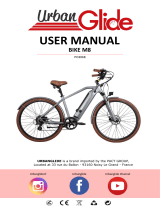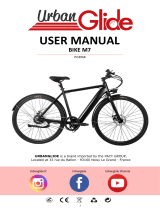
14
8. ARĪV eBike Warranty
What is Covered
This warranty covers repairs to correct any defects due to materials or workmanship in:
• The bicycle frame, fork, and other proprietary components, for a period of 5 years from the date of original
purchase. Proprietary components include: steer tube riser, handlebars, folding mechanism and associated
components, head light, integrated display and their related components.
• The motor and battery for a period of 2 years from the date of purchase.
This warranty covers repairs to correct any defects due to materials or workmanship in installed components (non GM) for
a period of 1 year or for the duration of the original manufacturer’s standard warranty period, whichever is longer. Installed
components are installed at the time of assembly and include: pedals, cranks, shifters, grips, saddle, seat post, seat post
collar, tires, tubes, rims, hubs, spokes, brake calipers, brake levers, and brake pads.
This warranty only applies to the original owner and is non-transferrable. Proof of purchase will be required to file a
warranty claim. This warranty is expressly limited to the repair or replacement of the defective item and is the sole remedy
of the warranty. This warranty only applies to a ARĪV eBike purchased from an authorized retailer or distributor.
What is not Covered
This warranty does not cover any of the following:
• Normal wear and tear; examples of wear items include but are not limited to: tires, tubes, rims, spokes, brake
pads, grips, shift cables and housings, and saddle covers.
• Improper assembly at time of purchase
• Improper follow-up maintenance
• Installation of components, parts or accessories not originally intended for or compatible with the bicycle as sold
• Damage or failure due to chemical treatments, collision, fire, theft, freezing, vandalism, riot, explosion, airborne
fallout, rail dust, salt from sea air, road salt or other materials used to control road conditions, chemicals, tree sap,
stones, hail, water or flood, windstorm, lightning, earthquake other environmental conditions, road hazard, or
objects striking the bicycle
• Damage or failure due to misuse, abuse, alteration, modification, tampering, or neglect.
o Misuse includes: driving over curbs, overloading, racing, or other competition.
o Neglect includes: corrosion due to excessive exposure to wet environments, prolonged exposure to
excessive heat or cold, damage due to improper charging, or damage caused by power surges during
charging.
This warranty is void in its entirety if any modification or alteration is made to the frame, fork or installed proprietary or non-
proprietary components.
Warranty Service
Warranty service must be performed by an ASP (ASP). A list of providers may be found at www.arivmobility.com
EN





















